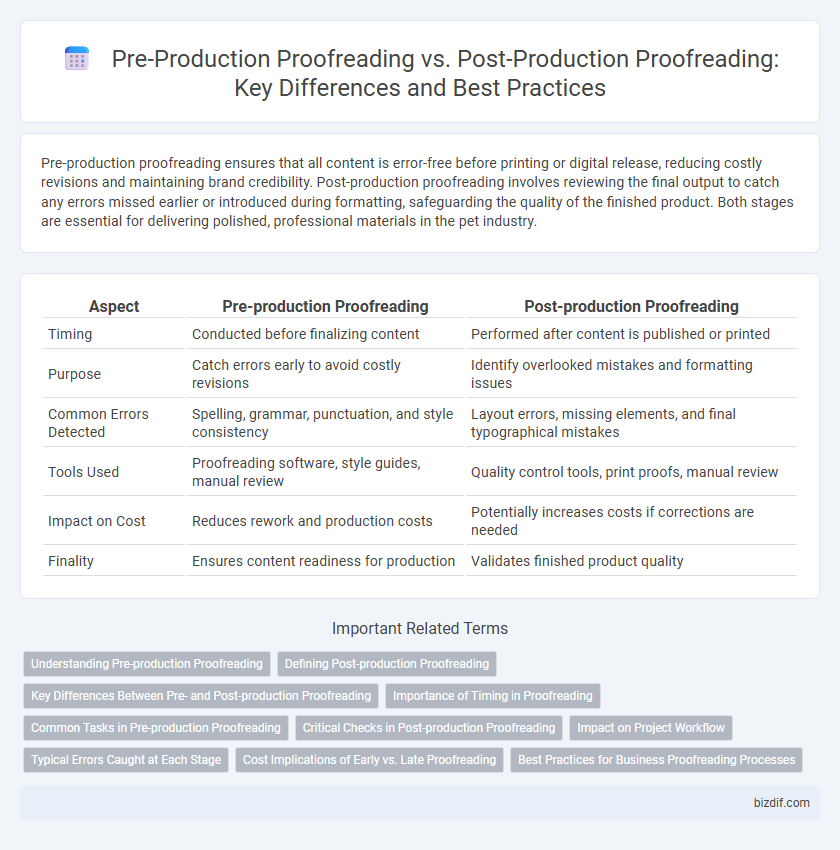Pre-production proofreading ensures that all content is error-free before printing or digital release, reducing costly revisions and maintaining brand credibility. Post-production proofreading involves reviewing the final output to catch any errors missed earlier or introduced during formatting, safeguarding the quality of the finished product. Both stages are essential for delivering polished, professional materials in the pet industry.
Table of Comparison
| Aspect | Pre-production Proofreading | Post-production Proofreading |
|---|---|---|
| Timing | Conducted before finalizing content | Performed after content is published or printed |
| Purpose | Catch errors early to avoid costly revisions | Identify overlooked mistakes and formatting issues |
| Common Errors Detected | Spelling, grammar, punctuation, and style consistency | Layout errors, missing elements, and final typographical mistakes |
| Tools Used | Proofreading software, style guides, manual review | Quality control tools, print proofs, manual review |
| Impact on Cost | Reduces rework and production costs | Potentially increases costs if corrections are needed |
| Finality | Ensures content readiness for production | Validates finished product quality |
Understanding Pre-production Proofreading
Pre-production proofreading involves reviewing content before it enters the production phase to identify and correct errors in grammar, spelling, and formatting, ensuring a clean and accurate source document. This stage focuses on preventing mistakes that could escalate costs or delays during printing or digital publishing. By catching issues early in text drafts, designers and editors maintain workflow efficiency and uphold high-quality standards before final production.
Defining Post-production Proofreading
Post-production proofreading occurs after the final layout and design of a document or publication have been completed, focusing on catching errors that may have emerged during formatting, typesetting, or printing. This phase ensures the accuracy of text alignment, fonts, and visual elements, confirming that no typographical or graphical mistakes persist prior to distribution. Unlike pre-production proofreading, which targets content accuracy in drafts, post-production proofreading validates the integrity of the final product for publication.
Key Differences Between Pre- and Post-production Proofreading
Pre-production proofreading focuses on identifying and correcting errors during the content creation phase, ensuring accuracy before final design or formatting. Post-production proofreading occurs after layout and design are complete, targeting issues that arise from formatting changes, such as font inconsistencies or alignment errors. Key differences include the timing within the workflow and the types of errors addressed, with pre-production emphasizing textual accuracy and post-production concentrating on visual and formatting correctness.
Importance of Timing in Proofreading
Pre-production proofreading is crucial for identifying and correcting errors before the content moves into the costly stages of design, printing, or publishing, ensuring accuracy early in the workflow. Post-production proofreading serves as a final quality control, catching overlooked mistakes and verifying that no new errors were introduced during production. Timely proofreading in both phases minimizes rework, reduces delays, and maintains the integrity of the final product.
Common Tasks in Pre-production Proofreading
Common tasks in pre-production proofreading include verifying scripts for spelling, grammar, and punctuation errors to ensure content accuracy before printing or digital release. Reviewing layout consistency, such as font styles, headings, and formatting, prevents design discrepancies in the final product. Ensuring adherence to brand guidelines and style sheets supports uniformity across all marketing and publication materials.
Critical Checks in Post-production Proofreading
Critical checks in post-production proofreading involve verifying final layout accuracy, ensuring all design elements align perfectly with the text, and spotting typographical errors missed during pre-production. This stage emphasizes consistency in fonts, colors, and spacing to guarantee the published material meets quality standards. Detecting any overlooked errors before distribution prevents costly revisions and protects brand credibility.
Impact on Project Workflow
Pre-production proofreading enhances project workflow by identifying and correcting errors early, reducing costly revisions during later stages and ensuring clarity before design and printing. Post-production proofreading, conducted after initial production stages, helps catch residual mistakes but can cause delays and increase costs when significant changes are necessary. Prioritizing pre-production proofreading streamlines timelines and maintains project budgets by minimizing rework and last-minute corrections.
Typical Errors Caught at Each Stage
Pre-production proofreading typically catches errors such as typographical mistakes, formatting inconsistencies, and incorrect information like dates or names, ensuring the content aligns with original specifications before finalization. Post-production proofreading focuses on errors introduced during the production process, including print defects, color inaccuracies, and layout misalignments, verifying that the output matches the approved proof. Both stages are critical for maintaining quality control and preventing costly revisions after distribution.
Cost Implications of Early vs. Late Proofreading
Pre-production proofreading significantly reduces overall costs by identifying and correcting errors before content moves into expensive design and printing stages, preventing costly revisions. Post-production proofreading often leads to higher expenses due to rework, delays, and potential waste of materials if errors are discovered after finalization. Investing in early proofreading enhances budget efficiency and minimizes resource loss throughout the production cycle.
Best Practices for Business Proofreading Processes
Pre-production proofreading emphasizes catching errors early during content development, ensuring text accuracy before design and formatting stages, which reduces costly revisions later. Post-production proofreading focuses on reviewing finalized layouts and formatted documents to identify typographical, formatting, and consistency errors that may have been introduced during production. Implementing a dual-stage proofreading process enhances overall quality control, streamlines workflow, and minimizes risks of releasing flawed business materials.
Pre-production proofreading vs Post-production proofreading Infographic

 bizdif.com
bizdif.com